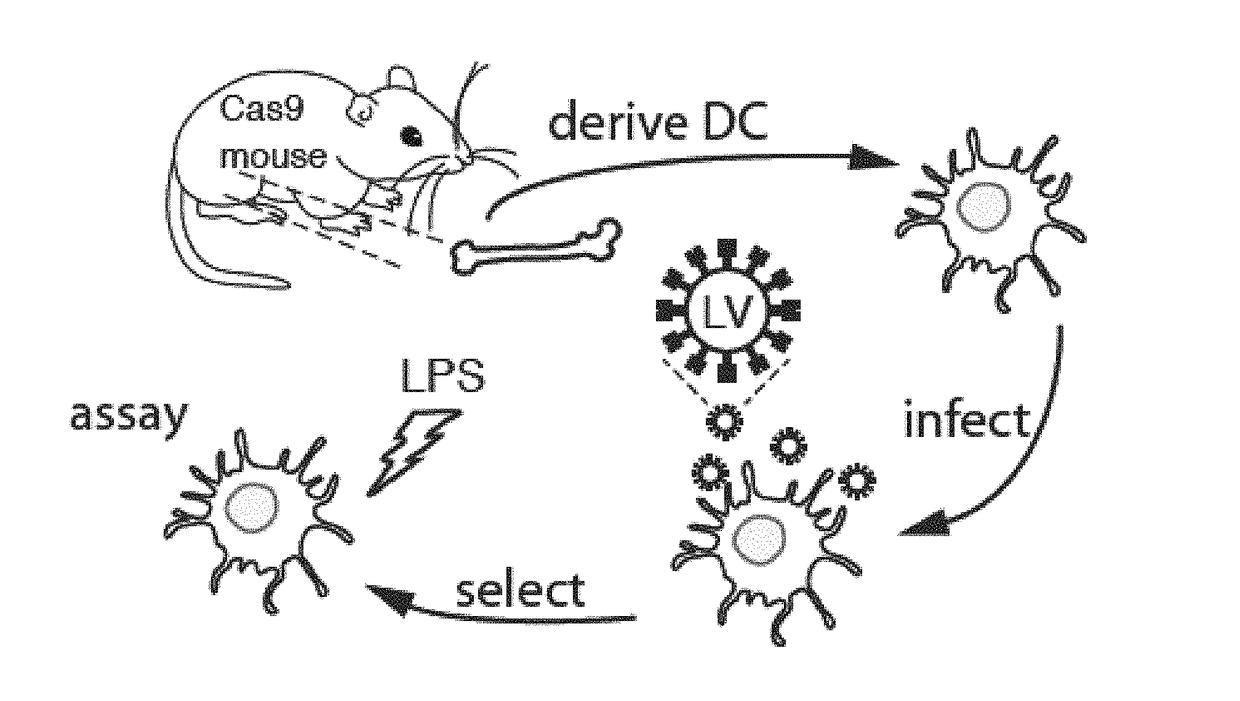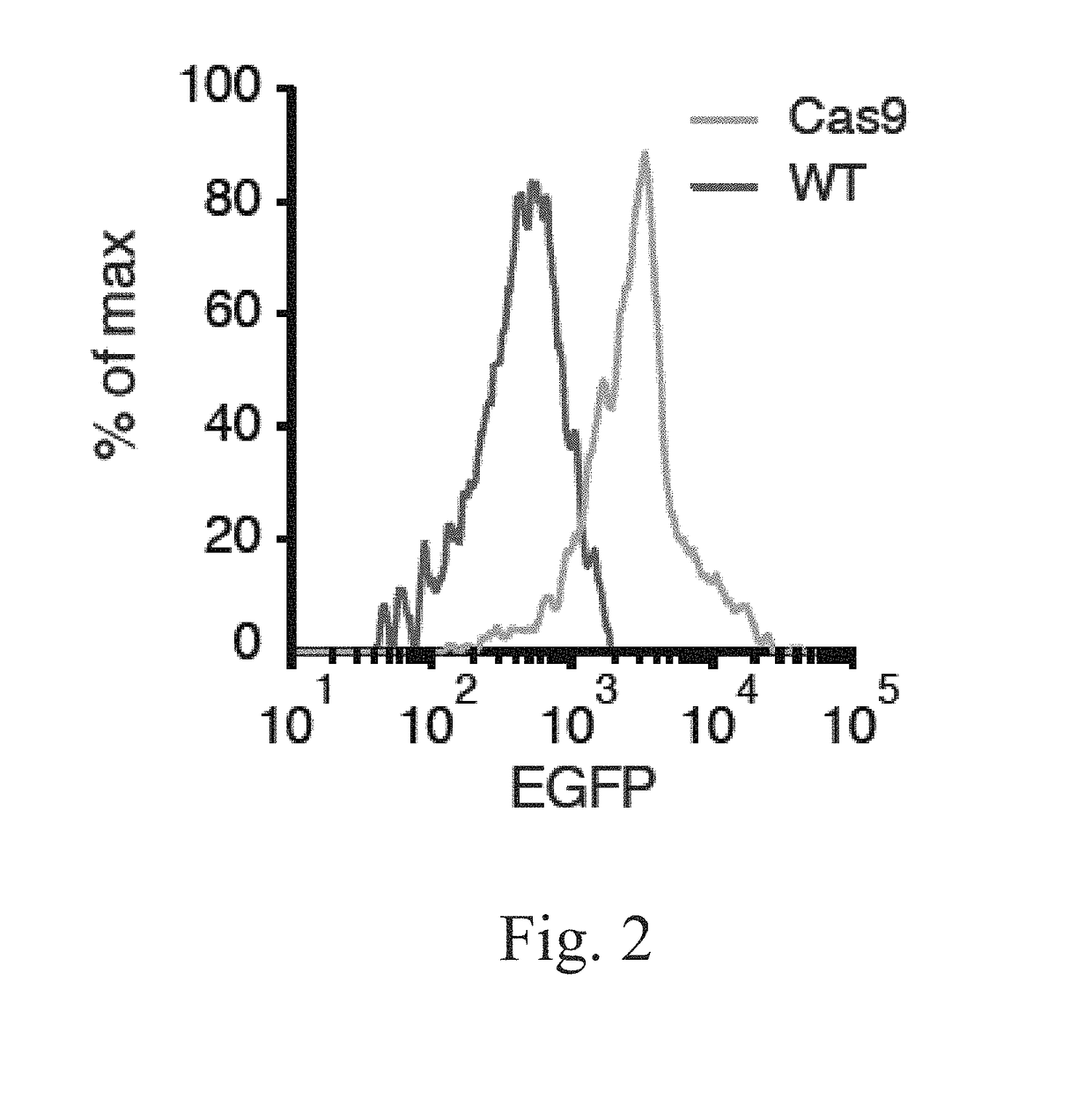Delivery, use and therapeutic applications of the crispr-cas systems and compositions for modeling mutations in leukocytes
a technology of leukocytes and crisprcas, which is applied in the direction of active genetic ingredients, viruses/bacteriophages, and general ingredients of the product, can solve the problems of ineffective strategies, limited tools available in mammals, and difficult application of perturbation strategies on a genomic scale, and achieves the effects of modulating leukocyte activity, increasing and reducing the transcription of the target gen
- Summary
- Abstract
- Description
- Claims
- Application Information
AI Technical Summary
Benefits of technology
Problems solved by technology
Method used
Image
Examples
example 1
sgenic and Knock in Mice
[0204]Reference is made to WO 2014 / 093622 (PCT / US13 / 74667), incorporated herein by reference. To generate a mouse that expresses the Cas9 nuclease Applicants submit two general strategies, transgenic and knock in. These strategies may be applied to generate any other model organism of interest, for e.g. Rat. For each of the general strategies Applicants made a constitutively active Cas9 and a Cas9 that is conditionally expressed (Cre recombinase dependent). The constitutively active Cas9 nuclease is expressed in the following context: pCAG-NLS-Cas9-NLS-P2A-EGFP-WPRE-bGHpolyA. pCAG is the promoter, NLS is a nuclear localization signal, P2A is the peptide cleavage sequence, EGFP is enhanced green fluorescent protein, WPRE is the woodchuck hepatitis virus posttranscriptional regulatory element, and bGHpolyA is the bovine growth hormone poly-A signal sequence. The conditional version has one additional stop cassette element, loxP-SV40 polyAx3-loxP, after the prom...
example 2
enome Editing in Primary Dendritic Cells by Lentiviral-Mediated sgRNA Expression
[0210]To determine whether the Rosa26 knock-in construct provided functional levels of Cas9 expression, Applicants set out to test whether a previously described U6-sgRNA lentiviral vector (Sanjana et al., 2014) could mediate indel formation ex vivo in primary immune cells. Several types of immune cells, such as innate immune dendritic cells (DCs), are often not accessible for genetic manipulation due to delivery challenges, short viability terms in culture, or both. Moreover, since existing cell lines do not mimic DC biology well, many studies are performed with primary cells derived ex vivo from precursors isolated from the bone marrow (BMDCs) (FIG. 1), which retain many critical characteristics of DCs in vivo (Amit et al., 2009; Chevrier et al., 2011; Garber et al., 2012; Shalek et al., 2013). Applicants thus reasoned that Cas9-expressing cells derived from the constitutive Cas9-expressing mice may fa...
example 3
de CRISPR Screens in Primary Mouse Dendritic Cells
[0215]In this example, Applicants establish a genome wide screen for positive and negative regulators of the LPS response in primary mouse dendritic cells (DCs). Bone marrow cells from Cas-9 expressing transgenic mice are infected with a library of lenti-virus that contains six guide RNAs for each mouse gene (including miRNAs), plus negative control guides that do not target any sequence in the mouse genome. A mixture of mouse primary cells is created and grown in condition that promote differentiation towards DCs. In this cell mixture each cell contains on average one mutation in one of the targeted genes. The next stage is to stimulate DCs with LPS (a bacterial component) and then isolate cells that fail to respond (indication of a mutation in a positive regulator of the LPS response) or that have a stronger than normal response (indication of a mutation in a negative regulator of the response). The stimulation step is performed in...
PUM
| Property | Measurement | Unit |
|---|---|---|
| time | aaaaa | aaaaa |
| weight | aaaaa | aaaaa |
| total volume | aaaaa | aaaaa |
Abstract
Description
Claims
Application Information
 Login to View More
Login to View More - R&D
- Intellectual Property
- Life Sciences
- Materials
- Tech Scout
- Unparalleled Data Quality
- Higher Quality Content
- 60% Fewer Hallucinations
Browse by: Latest US Patents, China's latest patents, Technical Efficacy Thesaurus, Application Domain, Technology Topic, Popular Technical Reports.
© 2025 PatSnap. All rights reserved.Legal|Privacy policy|Modern Slavery Act Transparency Statement|Sitemap|About US| Contact US: help@patsnap.com



